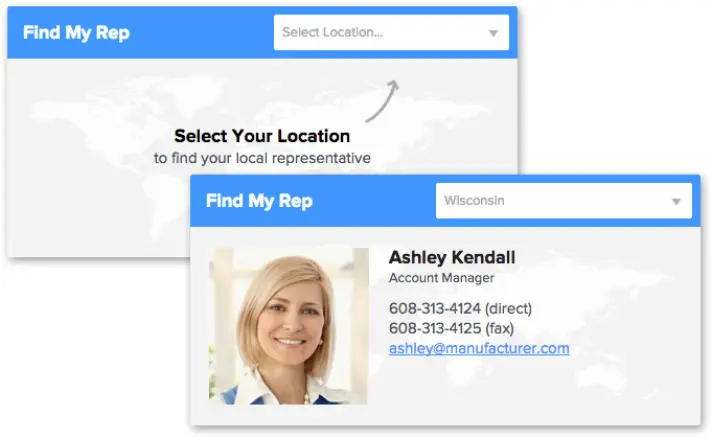Trends and Predictions in Manufacturing Website Design

Astuteo helps manufacturers pursue growth through web design, analytics, and digital marketing. Each company we work with owns a specific niche, but on the whole they face similar challenges – navigating long sales cycles and demand volatility, filling their pipelines with qualified web leads, retaining great engineers, and more. Taking a look at today and beyond, here are the biggest changes we see happening on manufacturing websites.
Re-examining SEO with quality in mind
At this point, marketing directors have been around the block with SEO vendors and achieved moderate success. In most cases, however, the additional traffic hasn’t resulted in more leads. The days of feeling good about increased page views are over, and the heat is on marketing to deliver new business. We think it’s fair to expect a more critical eye on SEO and paid search investments as leadership starts questioning their value from a conversion perspective (versus merely acquisition).
SEO isn't just about acquisition. Marketers need to reassess their most popular keywords from a conversion perspective.
As an example, one of our clients manufactures environmental monitoring systems – temperature sensors, differential pressure sensors, humidity sensors, etc. We found that their website was optimized for “temperature sensors” but not converting. Why? Probably because people seeking "temperature sensors” aren’t looking for $250,000 environmental monitoring systems. It’s not about high-volume search terms, it’s about the right search terms.
Repelling unqualified leads
Like page views, total web leads has been a feel-good metric for showing website progress. Misdirected campaigns and website overhauls have resulted in more inquiries, but B2B manufacturers aren’t selling hot dogs. With custom equipment, it’s very common for every phone call, every email, and every web form submission to require an engineer’s involvement.
This is a real problem. For one, good engineers are not easy to come by, and they have equipment to design. But as creatures of efficiency, fruitless customer service also exhausts them. Business owners and engineering directors will both be riding marketing about too many bad leads, if they aren’t already.
Engineers are creatures of efficiency. Fruitlessly consulting with too many unqualified leads will exhaust them.
So how do you deal with it? Information on pricing, intended markets, equipment capacities, and case studies can help to distill the audience. Quote request and contact forms should be concise, but ask specific questions that inform engineers and qualify leads. And when unqualified leads do slip through, engineers need to be able to fire back a PDF or project request form that prevents a 20-minute phone consultation with every unqualified contact.
Giving recruitment added weight on the website
Listen up, HR: Your glory days have arrived. For years, your Careers section has been nestled three levels deep under the Our Company tab, but no longer. A shortage of skilled laborers and engineers has become an anchor dragging behind America’s growing manufacturers.
Talent recruitment is holding back manufacturers. It's time to give Careers a prominent spot in the main navigation.
The good news is America is focused on STEM education. Law school applications are down; engineering applications are soaring. Ten years from now, we’ll be all set. In the meantime though, recruitment is going to get its due. In addition to more prominent positioning for Careers (Benefits, Current Openings, Apply Now, etc.), we also expect to see more well-produced videos on manufacturers' websites and LinkedIn pages. There’s no better way to showcase what a company is all about.
Putting marketing automation platforms to greater use
Manufacturers are a group on the cusp when it comes to achieving huge returns from advanced marketing and analytics platforms. Take for example a product like Act-On which ties webpage visits, email opens, PDF downloads, and form submissions all back to a particular customer, company, or competitor. If you’re making big deals in a niche market space, this intelligence is gold for your sales team.
Manufacturers are a group on the cusp when it comes to achieving huge returns from advanced marketing and analytics platforms.
With smaller marketing teams, manufacturers will still run into the most common problem with these platforms – adoption. Somebody has to put the hours into actually learning and using the system, after all. But it is worth it, and we expect manufacturers to make steady progress integrating these tools into their sales and marketing.
Making the closing process personal
Both professionally and as consumers themselves, business leaders understand how the web has transformed traditional sales processes. Buyers now complete anywhere from 57% to 67% of their decision-making process online. Cue the content marketing frenzy.
But what about closing the deal? If buyers aren’t reaching out until the end of the process, that means you need your best people standing by. Not a toll-free 800 number, not sales@yourcompany.com, but a friendly face with a name and a personal email address. In other words, a relationship.
Many of our clients already have Find a Sales Rep or How To Buy features implemented on their websites. These personal calls-to-action will spread as manufacturers realize the benefits of connecting customers directly to the team member who can best answer their questions.

Unifying the sales team with digital marketing
Salespeople have a tendency to make deals. From promising the moon, to impossible scheduling, or just creating their own special set of marketing materials, they're scrappy like that. Your company website just might be the tool you need to keep it all together.
Before sales can be optimized, it needs to be standardized. A solid digital marketing library can go a long way toward a consistent pitch.
Considering how much of the sales process is digital, sales reps love when their brochures, data sheets and product videos are easily available on the web. Manufacturing CEOs and production managers are finding they can control much of the sales pitch by providing a solid library of approved digital marketing materials. And product managers are thrilled, of course, by the ability to keep their messaging on point and consistent. As manufacturers and their sales & marketing teams grow, the company website should be the touchstone for consistent communications, proposals, and promises. It's a win-win-win.